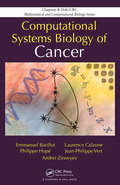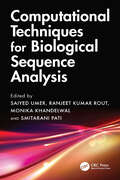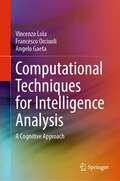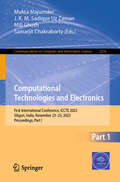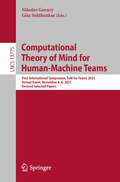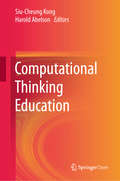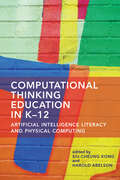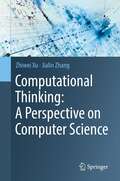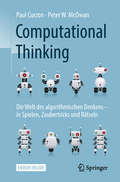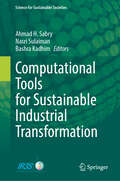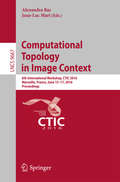- Table View
- List View
Computational Systems Biology of Cancer (Chapman & Hall/CRC Computational Biology Series)
by Emmanuel Barillot Laurence Calzone Philippe Hupe Jean-Philippe Vert Andrei ZinovyevThe future of cancer research and the development of new therapeutic strategies rely on our ability to convert biological and clinical questions into mathematical models-integrating our knowledge of tumour progression mechanisms with the tsunami of information brought by high-throughput technologies such as microarrays and next-generation sequencin
Computational Systems Biology: Methods And Protocols (Methods In Molecular Biology #1754)
by Tao HuangThis volume introduces the reader to the latest experimental and bioinformatics methods for DNA sequencing, RNA sequencing, cell-free tumour DNA sequencing, single cell sequencing, single-cell proteomics and metabolomics. Chapters detail advanced analysis methods, such as Genome-Wide Association Studies (GWAS), machine learning, reconstruction and analysis of gene regulatory networks and differential coexpression network analysis, and gave a practical guide for how to choose and use the right algorithm or software to handle specific high throughput data or multi-omics data. Written in the highly successful Methods in Molecular Biology series format, chapters include introductions to their respective topics, lists of the necessary materials and reagents, step-by-step, readily reproducible laboratory protocols, and tips on troubleshooting and avoiding known pitfalls.Authoritative and cutting-edge, Computational Systems Biology: Methods and Protocols aims to ensure successful results in the further study of this vital field.
Computational Techniques for Biological Sequence Analysis
by Ranjeet Kumar Rout Saiyed Umer Monika Khandelwal Smitarani PatiThis book provides an overview of basic and advanced computational techniques for analyzing and understanding protein, RNA, and DNA sequences. It covers effective computing techniques for DNA and protein classifications, evolutionary and sequence information analysis, evolutionary algorithms, and ensemble algorithms. Furthermore, the book reviews the role of machine learning techniques, artificial intelligence, ensemble learning, and sequence-based features in predicting post-translational modifications in proteins, DNA methylation, and mRNA methylation, along with their functional implications. The book also discusses the prediction of protein–protein and protein–DNA interactions, protein structure, and function using computational methods. It also presents techniques for quantitative analysis of protein–DNA interactions and protein methylation and their involvement in gene regulation. Additionally, the use of nature-inspired algorithms to gain insights into gene regulatory mechanisms and metabolic pathways in human diseases is explored. This book acts as a useful reference for bioinformaticians and computational biologists working in the fields of molecular biology, genomics, and bioinformatics.Key Features: Reviews machine learning techniques for DNA sequence classification and protein structure prediction Discusses genetic algorithms for analyzing multiple sequence alignments and predicting protein–protein interaction sites Explores computational methods for quantitative analysis of protein–DNA interactions Examine the role of nature-inspired algorithms in understanding the gene regulation and metabolic pathways Covers evolutionary algorithms and sequence-based features in predicting post-translational modifications
Computational Techniques for Human Smile Analysis (SpringerBriefs in Computer Science)
by Hassan Ugail Ahmad Ali AldahoudIn this book, the authors discuss the recent developments in computational techniques for automated non-invasive facial emotion detection and analysis with particular focus on the smile. By way of applications, they discuss how genuine and non-genuine smiles can be inferred, how gender is encoded in a smile and how it is possible to use the dynamics of a smile itself as a biometric feature. It is often said that the face is a window to the soul. Bearing a metaphor of this nature in mind, one might find it intriguing to understand, if any, how the physical, behavioural as well as emotional characteristics of a person could be decoded from the face itself. With the increasing deductive power of machine learning techniques, it is becoming plausible to address such questions through the development of appropriate computational frameworks. Though there are as many as over twenty five categories of emotions one could express, regardless of the ethnicity, gender or social class, across humanity, there exist six common emotions – namely happiness, sadness, surprise, fear, anger and disgust - all of which can be inferred from facial expressions. Of these facial expressions, the smile is the most prominent in social interactions. The smile bears important ramifications with beliefs such as it makes one more attractive, less stressful in upsetting situations and employers tending to promote people who smile often. Even pockets of scientific research appear to be forthcoming to validate such beliefs and claims, e.g. the smile intensity observed in photographs positively correlates with longevity, the ability to win a fight and whether a couple would stay married. Thus, it appears that many important personality traits are encoded in the smile itself. Therefore, the deployment of computer based algorithms for studying the human smiles in greater detail is a plausible avenue for which the authors have dedicated the discussions in this book.
Computational Techniques for Intelligence Analysis: A Cognitive Approach
by Vincenzo Loia Francesco Orciuoli Angelo GaetaThis book focuses on the definition and implementation of data-driven computational tools supporting decision-making along heterogeneous intelligence scenarios. Intelligence analysis includes methodologies, activities, and tools aimed at obtaining complex information from a set of isolated data gathered from different sensors. The tools aim at increasing the level of situation awareness of decision-makers through the construction of abstract structures supporting human operators in reasoning and making decisions. This book appeals to students, professionals, and academic researchers in computational intelligence and approximate reasoning applications. It is a comprehensive textbook on the subject, supported with case studies and practical examples in Python. The readers will learn how to define decision support systems for the intelligence analysis through the application of situation awareness and granular computing for information processing.
Computational Techniques for Structural Health Monitoring (Springer Series in Reliability Engineering)
by Srinivasan Gopalakrishnan Sathyanaraya Hanagud Massimo RuzzeneThe increased level of activity on structural health monitoring (SHM) in various universities and research labs has resulted in the development of new methodologies for both identifying the existing damage in structures and predicting the onset of damage that may occur during service. Designers often have to consult a variety of textbooks, journal papers and reports, because many of these methodologies require advanced knowledge of mechanics, dynamics, wave propagation, and material science. Computational Techniques for Structural Health Monitoring gives a one-volume, in-depth introduction to the different computational methodologies available for rapid detection of flaws in structures. Techniques, algorithms and results are presented in a way that allows their direct application. A number of case studies are included to highlight further the practical aspects of the selected topics. Computational Techniques for Structural Health Monitoring also provides the reader with numerical simulation tools that are essential to the development of novel algorithms for the interpretation of experimental measurements, and for the identification of damage and its characterization. Upon reading Computational Techniques for Structural Health Monitoring, graduate students will be able to begin research-level work in the area of structural health monitoring. The level of detail in the description of formulation and implementation also allows engineers to apply the concepts directly in their research.
Computational Techniques for Text Summarization based on Cognitive Intelligence
by V. Priya K. UmamaheswariThe book is concerned with contemporary methodologies used for automatic text summarization. It proposes interesting approaches to solve well-known problems on text summarization using computational intelligence (CI) techniques including cognitive approaches. A better understanding of the cognitive basis of the summarization task is still an open research issue; an extent of its use in text summarization is highlighted for further exploration. With the ever-growing text, people in research have little time to spare for extensive reading, where summarized information helps for a better understanding of the context at a shorter time. This book helps students and researchers to automatically summarize the text documents in an efficient and effective way. The computational approaches and the research techniques presented guides to achieve text summarization at ease. The summarized text generated supports readers to learn the context or the domain at a quicker pace. The book is presented with reasonable amount of illustrations and examples convenient for the readers to understand and implement for their use. It is not to make readers understand what text summarization is, but for people to perform text summarization using various approaches. This also describes measures that can help to evaluate, determine, and explore the best possibilities for text summarization to analyse and use for any specific purpose. The illustration is based on social media and healthcare domain, which shows the possibilities to work with any domain for summarization. The new approach for text summarization based on cognitive intelligence is presented for further exploration in the field.
Computational Technologies and Electronics: First International Conference, ICCTE 2023, Siliguri, India, November 23–25, 2023, Proceedings, Part I (Communications in Computer and Information Science #2376)
by Samarjit Chakraborty Mukta Majumder J. K. M. Sadique Uz Zaman Mili GhoshThis two-volume set, CCIS 2376 and CCIS 2377, constitutes proceedings from the First International Conference on Computational Technologies and Electronics, ICCTE 2023, held in Siliguri, India, during November 23–25, 2023. The 46 full papers presented here were carefully selected and reviewed from 157 submissions. These papers have been organized in the following topical sections: Pat I- Pattern recognition & AI Part II- Data communication & security; Applied electronics.
Computational Technologies and Electronics: First International Conference, ICCTE 2023, Siliguri, India, November 23–25, 2023, Proceedings, Part II (Communications in Computer and Information Science #2377)
by Samarjit Chakraborty Mukta Majumder J. K. M. Sadique Uz Zaman Mili GhoshThis two-volume set, CCIS 2376 and CCIS 2377, constitutes proceedings from the First International Conference on Computational Technologies and Electronics, ICCTE 2023, held in Siliguri, India, during November 23–25, 2023. The 46 full papers presented here were carefully selected and reviewed from 157 submissions. These papers have been organized in the following topical sections: Pat I- Pattern recognition & AI Part II- Data communication & security; Applied electronics.
Computational Technology For Effective Health Care: Immediate Steps And Strategic Directions
by National Research Council of the National AcademiesDespite a strong commitment to delivering quality health care, persistent problems involving medical errors and ineffective treatment continue to plague the industry. Many of these problems are the consequence of poor information and technology (IT) capabilities, and most importantly, the lack cognitive IT support. Clinicians spend a great deal of time sifting through large amounts of raw data, when, ideally, IT systems would place raw data into context with current medical knowledge to provide clinicians with computer models that depict the health status of the patient. Computational Technology for Effective Health Care advocates re-balancing the portfolio of investments in health care IT to place a greater emphasis on providing cognitive support for health care providers, patients, and family caregivers; observing proven principles for success in designing and implementing IT; and accelerating research related to health care in the computer and social sciences and in health/biomedical informatics. Health care professionals, patient safety advocates, as well as IT specialists and engineers, will find this book a useful tool in preparation for crossing the health care IT chasm.
Computational Theory of Mind for Human-Machine Teams: First International Symposium, ToM for Teams 2021, Virtual Event, November 4–6, 2021, Revised Selected Papers (Lecture Notes in Computer Science #13775)
by Gita Sukthankar Nikolos GurneyThis book constitutes the proceedings of the First International Symposium, ToM for Teams 2021, held in Washington, DC, USA, during November 4–6, 2021, Each chapter in this section tackles a different aspect of AI representing the thoughts and beliefs of human agents. The work presented herein represents our collective efforts to better understand ToM, develop AI with ToM capabilities (ASI), and study how to integrate such systems into human teams.
Computational Thermo-kinetics of Rigid Polyurethane Foams: Theory and Applications (SpringerBriefs in Applied Sciences and Technology)
by Arnold A. Lubguban Roberto M. Malaluan Gerard G. Dumancas Arnold C. AlgunoThis book presents a detailed exploration of advanced computational modeling techniques in the design, testing, and applications of rigid polyurethane foams (RPUFs). By leveraging modern approaches such as database-driven predictions, iterative simulations, and emerging innovations in computational material engineering, it offers a more accurate and efficient way to model the thermo-kinetic behavior of RPUFs. The necessity for computational tools in materials science is intertwined with the growth of the polyurethane market, with many academic and industrial researchers seeking to adopt these methods. The book comprehensively discusses the advancement in bridging the gap between traditional empirical methods and cutting-edge computational techniques specifically applied to RPUFs. Furthermore, it is a comprehensive guide to the computational modeling of the thermo-kinetics of RPUFs, making it an essential resource for researchers, engineers, and academicians seeking to innovate in material science and engineering. This book addresses a niche yet critical area within this broader scope.
Computational Thinking (The MIT Press Essential Knowledge Series)
by Matti Tedre Peter J. DenningAn introduction to computational thinking that traces a genealogy beginning centuries before the digital computer. A few decades into the digital era, scientists discovered that thinking in terms of computation made possible an entirely new way of organizing scientific investigation; eventually, every field had a computational branch: computational physics, computational biology, computational sociology. More recently, “computational thinking” has become part of the K–12 curriculum. But what is computational thinking? This volume in the MIT Press Essential Knowledge series offers an accessible overview, tracing a genealogy that begins centuries before digital computers and portraying computational thinking as pioneers of computing have described it. The authors explain that computational thinking (CT) is not a set of concepts for programming; it is a way of thinking that is honed through practice: the mental skills for designing computations to do jobs for us, and for explaining and interpreting the world as a complex of information processes. Mathematically trained experts (known as “computers”) who performed complex calculations as teams engaged in CT long before electronic computers. The authors identify six dimensions of today's highly developed CT—methods, machines, computing education, software engineering, computational science, and design—and cover each in a chapter. Along the way, they debunk inflated claims for CT and computation while making clear the power of CT in all its complexity and multiplicity.
Computational Thinking Education
by Siu-Cheung Kong Harold AbelsonThis This book is open access under a CC BY 4.0 license.This book offers a comprehensive guide, covering every important aspect of computational thinking education. It provides an in-depth discussion of computational thinking, including the notion of perceiving computational thinking practices as ways of mapping models from the abstraction of data and process structures to natural phenomena. Further, it explores how computational thinking education is implemented in different regions, and how computational thinking is being integrated into subject learning in K-12 education. In closing, it discusses computational thinking from the perspective of STEM education, the use of video games to teach computational thinking, and how computational thinking is helping to transform the quality of the workforce in the textile and apparel industry.
Computational Thinking Education in K-12: Artificial Intelligence Literacy and Physical Computing
by Siu-Cheung Kong and Harold AbelsonA guide to computational thinking education, with a focus on artificial intelligence literacy and the integration of computing and physical objects. Computing has become an essential part of today&’s primary and secondary school curricula. In recent years, K–12 computer education has shifted from computer science itself to the broader perspective of computational thinking (CT), which is less about technology than a way of thinking and solving problems—&“a fundamental skill for everyone, not just computer scientists,&” in the words of Jeanette Wing, author of a foundational article on CT. This volume introduces a variety of approaches to CT in K–12 education, offering a wide range of international perspectives that focus on artificial intelligence (AI) literacy and the integration of computing and physical objects. The book first offers an overview of CT and its importance in K–12 education, covering such topics as the rationale for teaching CT; programming as a general problem-solving skill; and the &“phenomenon-based learning&” approach. It then addresses the educational implications of the explosion in AI research, discussing, among other things, the importance of teaching children to be conscientious designers and consumers of AI. Finally, the book examines the increasing influence of physical devices in CT education, considering the learning opportunities offered by robotics. ContributorsHarold Abelson, Cynthia Breazeal, Karen Brennan, Michael E. Caspersen, Christian Dindler, Daniella DiPaola, Nardie Fanchamps, Christina Gardner-McCune, Mark Guzdial, Kai Hakkarainen, Fredrik Heintz, Paul Hennissen, H. Ulrich Hoppe, Ole Sejer Iversen, Siu-Cheung Kong, Wai-Ying Kwok, Sven Manske, Jesús Moreno-León, Blakeley H. Payne, Sini Riikonen, Gregorio Robles, Marcos Román-González, Pirita Seitamaa-Hakkarainen, Ju-Ling Shih, Pasi Silander, Lou Slangen, Rachel Charlotte Smith, Marcus Specht, Florence R. Sullivan, David S. Touretzky
Computational Thinking and Coding for Every Student: The Teacher’s Getting-Started Guide
by Jane Krauss Kiki ProttsmanEmpower tomorrow’s tech innovators Our students are avid users and consumers of technology. Isn’t it time that they see themselves as the next technological innovators, too? Computational Thinking and Coding for Every Student is the beginner’s guide for K-12 educators who want to learn to integrate the basics of computer science into their curriculum. Readers will find Practical strategies for teaching computational thinking and the beginning steps to introduce coding at any grade level, across disciplines, and during out-of-school time Instruction-ready lessons and activities for every grade Specific guidance for designing a learning pathway for elementary, middle, or high school students Justification for making coding and computer science accessible to all A glossary with definitions of key computer science terms, a discussion guide with tips for making the most of the book, and companion website with videos, activities, and other resources Momentum for computer science education is growing as educators and parents realize how fundamental computing has become for the jobs of the future. This book is for educators who see all of their students as creative thinkers and active contributors to tomorrow’s innovations. "Kiki Prottsman and Jane Krauss have been at the forefront of the rising popularity of computer science and are experts in the issues that the field faces, such as equity and diversity. In this book, they’ve condensed years of research and practitioner experience into an easy to read narrative about what computer science is, why it is important, and how to teach it to a variety of audiences. Their ideas aren’t just good, they are research-based and have been in practice in thousands of classrooms…So to the hundreds and thousands of teachers who are considering, learning, or actively teaching computer science—this book is well worth your time." Pat Yongpradit Chief Academic Officer, Code.org
Computational Thinking and Coding for Every Student: The Teacher’s Getting-Started Guide
by Jane Krauss Kiki ProttsmanEmpower tomorrow’s tech innovators Our students are avid users and consumers of technology. Isn’t it time that they see themselves as the next technological innovators, too? Computational Thinking and Coding for Every Student is the beginner’s guide for K-12 educators who want to learn to integrate the basics of computer science into their curriculum. Readers will find Practical strategies for teaching computational thinking and the beginning steps to introduce coding at any grade level, across disciplines, and during out-of-school time Instruction-ready lessons and activities for every grade Specific guidance for designing a learning pathway for elementary, middle, or high school students Justification for making coding and computer science accessible to all A glossary with definitions of key computer science terms, a discussion guide with tips for making the most of the book, and companion website with videos, activities, and other resources Momentum for computer science education is growing as educators and parents realize how fundamental computing has become for the jobs of the future. This book is for educators who see all of their students as creative thinkers and active contributors to tomorrow’s innovations. "Kiki Prottsman and Jane Krauss have been at the forefront of the rising popularity of computer science and are experts in the issues that the field faces, such as equity and diversity. In this book, they’ve condensed years of research and practitioner experience into an easy to read narrative about what computer science is, why it is important, and how to teach it to a variety of audiences. Their ideas aren’t just good, they are research-based and have been in practice in thousands of classrooms…So to the hundreds and thousands of teachers who are considering, learning, or actively teaching computer science—this book is well worth your time." Pat Yongpradit Chief Academic Officer, Code.org
Computational Thinking for the Modern Problem Solver (Chapman & Hall/CRC Textbooks in Computing)
by David Riley Kenny A. HuntThrough examples and analogies, Computational Thinking for the Modern Problem Solver introduces computational thinking as part of an introductory computing course and shows how computer science concepts are applicable to other fields. It keeps the material accessible and relevant to noncomputer science majors.With numerous color figures, this class
Computational Thinking in Education: A Pedagogical Perspective
by Aman YadavComputational Thinking in Education explores the relevance of computational thinking in primary and secondary education. As today’s school-aged students prepare to live and work in a thoroughly digitized world, computer science is providing a wealth of new learning concepts and opportunities across domains. This book offers a comprehensive overview of computational thinking, its history, implications for equity and inclusion, analyses of competencies in practice, and integration into learning, instruction, and assessment through scaffolded teacher education. Computer science education faculty and pre- and in-service educators will find a fresh pedagogical approach to computational thinking in primary and secondary classrooms.
Computational Thinking in the STEM Disciplines: Foundations And Research Highlights
by Myint Swe KhineThis book covers studies of computational thinking related to linking, infusing, and embedding computational thinking elements to school curricula, teacher education and STEM related subjects. Presenting the distinguished and exemplary works by educators and researchers in the field highlighting the contemporary trends and issues, creative and unique approaches, innovative methods, frameworks, pedagogies and theoretical and practical aspects in computational thinking. A decade ago the notion of computational thinking was introduced by Jeannette Wing and envisioned that computational thinking will be a fundamental skill that complements to reading, writing and arithmetic for everyone and represents a universally applicable attitude. The computational thinking is considered a thought processes involved in a way of solving problems, designing systems, and understanding human behaviour. Assimilating computational thinking at young age will assist them to enhance problem solving skills, improve logical reasoning, and advance analytical ability - key attributes to succeed in the 21st century. Educators around the world are investing their relentless effort in equipping the young generation with real-world skills ready for the demand and challenges of the future. It is commonly believed that computational thinking will play a pivotal and dominant role in this endeavour. Wide-ranging research on and application of computational thinking in education have been emerged in the last ten years. This book will document attempts to conduct systematic, prodigious and multidisciplinary research in computational thinking and present their findings and accomplishments.
Computational Thinking: A Beginner's Guide to Problem-Solving and Programming
by Karl BeecherComputational thinking is a timeless, transferable skill that enables you to think more clearly and logically, as well as a way to solve specific problems. <p><p> Beginning with the core ideas of computational thinking, with this book you'll build up an understanding of the practical problem-solving approach and explore how computational thinking aids good practice in programming, complete with a full guided example.
Computational Thinking: A Perspective on Computer Science
by Jialin Zhang Zhiwei XuThis textbook is intended as a textbook for one-semester, introductory computer science courses aimed at undergraduate students from all disciplines. Self-contained and with no prerequisites, it focuses on elementary knowledge and thinking models. The content has been tested in university classrooms for over six years, and has been used in summer schools to train university and high-school teachers on teaching introductory computer science courses using computational thinking. This book introduces computer science from a computational thinking perspective. In computer science the way of thinking is characterized by three external and eight internal features, including automatic execution, bit-accuracy and abstraction. The book is divided into chapters on logic thinking, algorithmic thinking, systems thinking, and network thinking. It also covers societal impact and responsible computing material – from ICT industry to digital economy, from the wonder of exponentiation to wonder of cyberspace, and from code of conduct to best practices for independent work. The book’s structure encourages active, hands-on learning using the pedagogic tool Bloom's taxonomy to create computational solutions to over 200 problems of varying difficulty. Students solve problems using a combination of thought experiment, programming, and written methods. Only 300 lines of code in total are required to solve most programming problems in this book.
Computational Thinking: Des Welt des algorithmischen Denkens – in Spielen, Zaubertricks und Rätseln
by Paul Curzon Peter W. McOwan Bernhard GerlIn diesem Buch lernen Sie die Grundzüge und Vorteile des Computational Thinking kennen, also des analytischen, von Algorithmen geprägten Denkens. Die Autoren behandeln dabei unterhaltsam und anwendungsbezogen die Grundelemente dieser Denkweise - darunter Denken in Algorithmen, Zerlegung, Abstraktion und Mustererkennung. Diese Prinzipien werden anschaulich an Hand von Zaubertricks, Spielen und Rätseln, aber auch an echten, anspruchsvollen Problemen erklärt. Sie erkunden dabei auch die Verbindungen zwischen Computational Thinking und wissenschaftlichem, aber auch kreativem Denken - und wie daraus Innovationen entstehen können.Computational Thinking hat die Art und Weise, wie wir alle leben, arbeiten und spielen, verändert. Es hat Auswirkungen darauf, wie Wissenschaft betrieben wird, Kriege gewonnen, ganz neue Industrien geschaffen und Leben gerettet werden. Es ist das Herzstück der Programmierung und ein leistungsfähiger Ansatz zur Problemlösung, mit oder ohne Computer. In einigen Ländern werden bereits Kindern in der Grundschule diese Fertigkeiten beigebracht.Ob Sie also einfach wissen wollen, um was es beim Computational Thinking geht oder ob Sie neue Möglichkeiten finden wollen, auch im Alltag effektiver zu werden, ob Sie (Informatik-)Lehrer oder Schüler sind oder einfach Spaß an Spielen und Rätseln haben – in diesem Buch finden Sie die nötigen Grundlagen.
Computational Tools for Sustainable Industrial Transformation (Science for Sustainable Societies)
by Nasri Sulaiman Ahmad H. Sabry Bashra KadhimThis book discusses how computational tools are revolutionizing sustainable industrial transformation. By integrating advanced technologies such as big data analytics, machine learning, digital twins, and IoT, this volume provides a comprehensive guide to optimizing industrial processes for enhanced efficiency and reduced environmental impact. The chapters cover critical topics including the principles of industrial efficiency, the application of digital twins in manufacturing, and the application of machine learning and AI for process optimization and predictive maintenance. Readers will also explore the benefits of big data analytics in monitoring sustainability metrics and the role of IoT in smart sensor networks. Through real-world case studies and expert contributions, this book offers actionable insights into how computational tools can revolutionize industrial practices. The material presented significantly advances sustainability science by addressing key challenges and opportunities in the transition towards smart and sustainable societies. Through the integration of computational methods with industrial transformation, the book offers innovative solutions to pressing sustainability issues such as resource depletion, environmental degradation, and social inequality. Designed for industrial engineers, managers, and academics across disciplines such as engineering, environmental science, and business management, this book offers practical guidance on implementing computational techniques to optimize processes and reduce environmental impact. It invites readers to think through critical questions about sustainable practices and provides actionable insights that can be directly applied within industrial settings. By bridging theoretical knowledge with practical application, this book serves as an essential resource for professionals seeking to drive sustainable change in industry.
Computational Topology in Image Context: 6th International Workshop, CTIC 2016, Marseille, France, June 15-17, 2016, Proceedings (Lecture Notes in Computer Science #9667)
by Alexandra Bac Jean-Luc MariThis book constitutes the proceedings of the 6th International Workshop on Computational Topology in Image Context, CTIC 2016, held in Marseille, France, in June 2016. The 24 papers presented in this volume were carefully reviewed and selected from 35 submissions. Additionally, this volume contains 2 invited papers. CTIC covers a wide range of topics such as: topological invariants and their computation, homology, cohomology, linking number, fundamental groups; algorithm optimization in discrete geometry, transfer of mathematical tools, parallel computation in multi-dimensional volume context, hierarchical approaches; experimental evaluation of algorithms and heuristics; combinatorial or multi-resolution models; discrete or computational topology; geometric modeling guided by topological constraints; computational topological dynamics; and use of topological information in discrete geometry applications.
